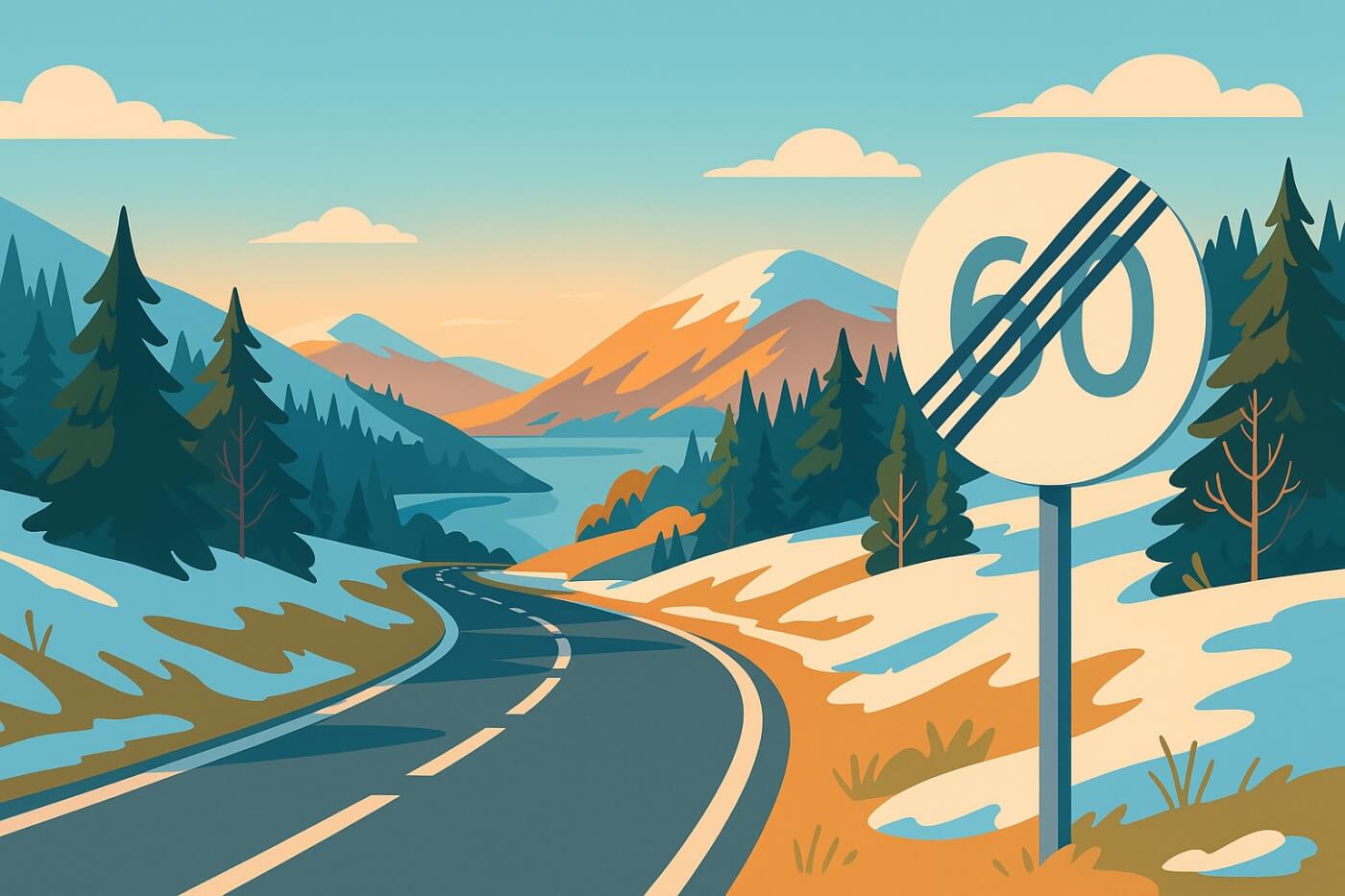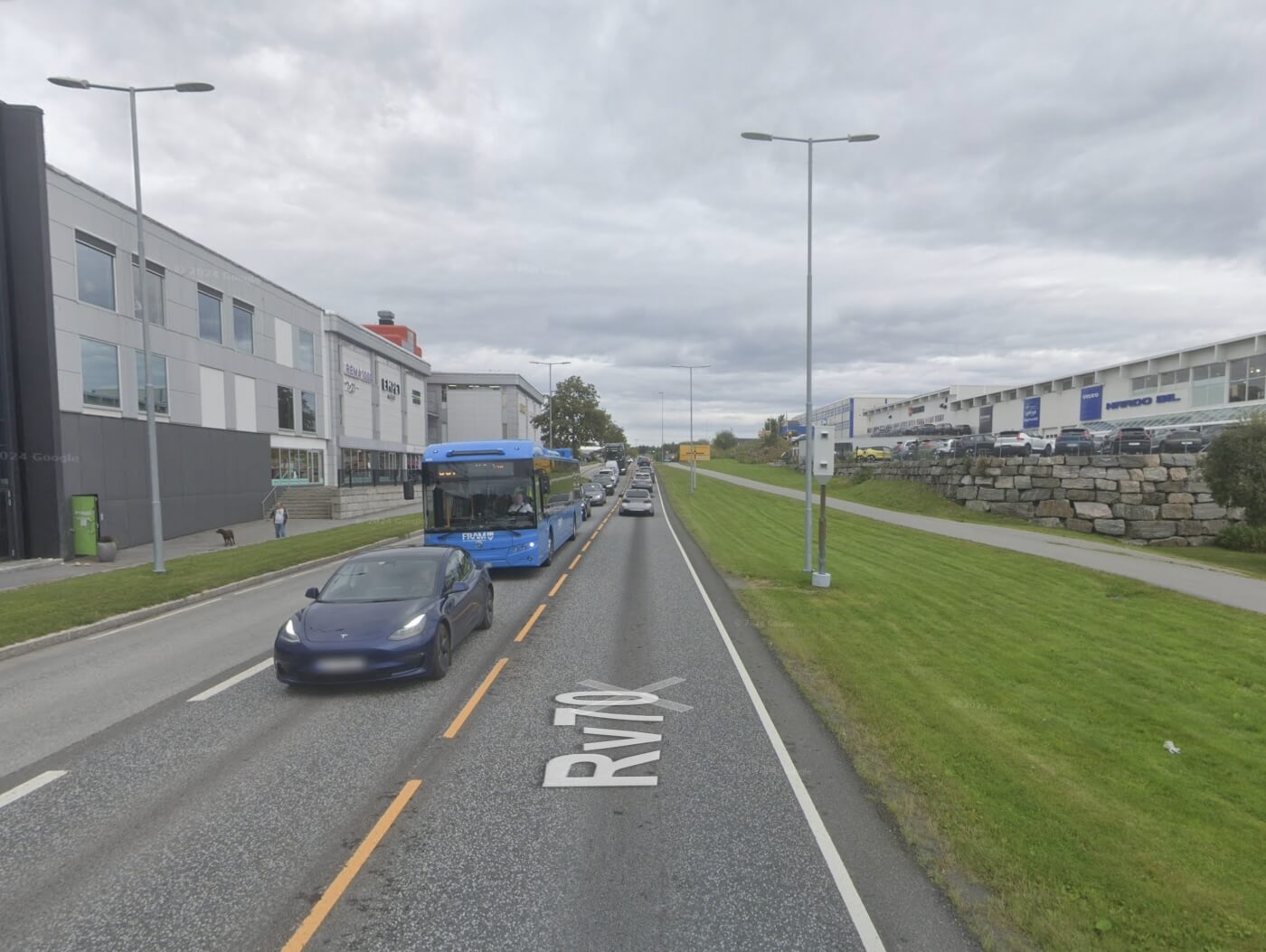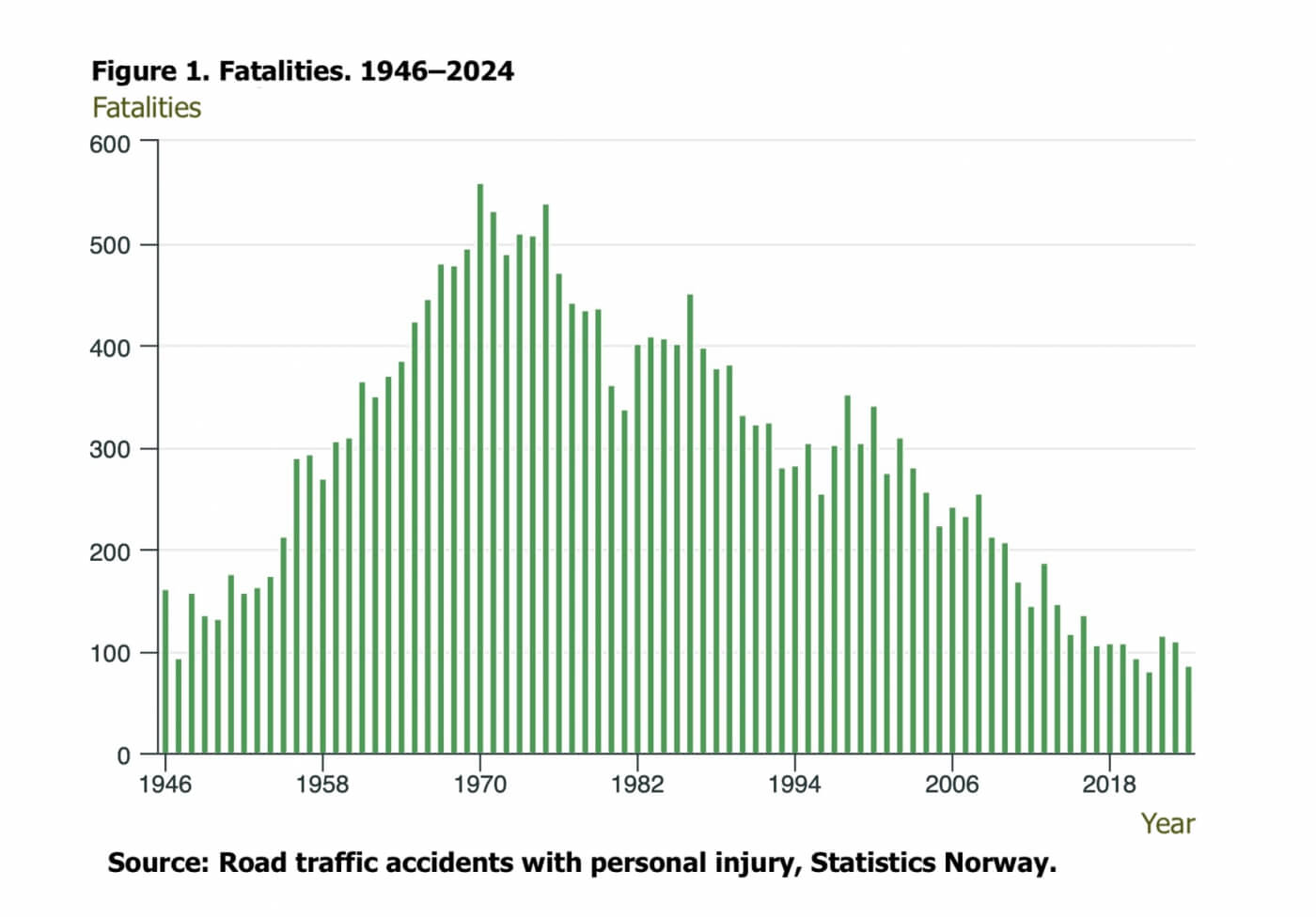Norway Speed Limits (2025): Rules, Fines & Cameras

Norway Speed Limits are straightforward once you know the basics: 50 km/h in towns, 80 km/h outside, and higher numbers only where they’re posted. This guide shows how that plays out for cars, motorcycles and motorhomes, plus what changes if you’re towing, how cameras work, and what fines look like.
Have you booked your car yet? Compare prices and coverage with our Norway car-rental search to lock in the right vehicle and insurance for your route.
TABLE OF CONTENTS
- 1. Norway speed limits by vehicle & road type
- 2. Legal framework & authorities
- 3. Fixed, mobile, and average-speed cameras
- 4. Fines, demerit points, suspensions & rental implications
- 5. Crashes, fatalities & socio-economic cost
- 6. FAQs
1. Norway speed limits by vehicle & road type
Speed limit matrix (vehicle × road)
| Vehicle | Urban | Rural | 2-lane E-roads | Motorway |
|---|---|---|---|---|
| Car / Moto >150 cc | 50 km/h | 80 km/h | 70–90 km/h | 100–110 km/h |
| Moto 50–125 cc | 50 km/h | 80 km/h | 70–90 km/h | 100–110 km/h |
| Campervan / Motorhome (≤3.5 t) |
50 km/h | 80 km/h | 70–90 km/h | 100–110 km/h |
| Motorhome (up to 7.5 t, M1) |
50 km/h | 80 km/h | 70–90 km/h | 100–110 km/h |
| Caravane / remorque (towed) |
50 km/h | 80 km/h (cap) | 80 km/h (cap) | 80 / 100 |
† Tempo 100 certification required for 100 km/h with a trailer/caravan.
The matrix above compresses Norway’s core logic into four columns you’ll actually meet on the road. If there’s no sign inside a built-up area, assume 50 km/h; leave town and the general rule becomes 80 km/h. Good two-lane highways (E-roads and national roads) are often signed somewhere between 70 and 90, while full motorways are posted at 100 or 110 depending on the standard of the stretch. Cars and motorcycles—big or small—simply follow the number that’s posted. Campervans up to 3.5 t do the same, and there’s a useful clarification for touring: M1 motorhomes up to 7.5 t are allowed to follow car limits as well, so they can legally keep pace up to 110 where that is signed.
Towing is the standout exception. A car with a caravan or trailer is capped at 80 km/h everywhere, even on 110 motorways. Only combinations that have passed the Norwegian Tempo 100 certification are allowed to travel at 100 km/h where appropriate—and you need the official approval and sticker to claim that privilege. If you don’t have it, think “80” by default.
Residential streets add one more layer of nuance. Many neighbourhoods and school areas run as 30-zones (signed at the zone entrance and exit), often with traffic-calming to make the limit feel natural. You may also see gatetun—home-street zones where drivers must proceed at a true walking pace and yield completely to people on foot. Treat these as special environments: the sign defines the rule, and the rule beats any “default.”
1.1 Specific exceptions & conditions
- Licences & experience: New Class B drivers have a two-year probation; any offence that carries points is doubled during this period (details in the penalties section).
- Weather & variable limits: Seasonal or electronic limits (often 10 km/h lower in winter, or dynamically reduced for weather/air quality) are legally binding and override the static sign until cleared.
- Road works: Temporary work-zone limits apply for the entire marked stretch; slow down and follow the posted number.
- Tempo 100 trailers: Only certified car-and-trailer combinations may run 100 km/h; otherwise the towing limit is 80 km/h.
- Tunnels & section control: Tunnels usually adopt the road’s limit but are often signed lower for safety (e.g., 70); many long tunnels and risky stretches use average-speed enforcement—watch the signs.
- Minimum-speed roads: On motortrafikkvei and motorways, vehicles must be capable of at least ~40 km/h; mopeds are not allowed.
2) Legal framework & authorities
Norway’s speed limits are grounded in the Road Traffic Act (Vegtrafikkloven), which sets the two general limits—50 km/h in built-up areas and 80 km/h outside—and authorises any other (special, temporary or variable) limits by posting official signs. See Section 6 of the Road Traffic Act (Vegtrafikkloven).
Who sets and signs the limits? Statens vegvesen applies national criteria to decide limits on state/county roads, while municipalities handle local streets (e.g., 30-zones) in consultation with the police. Which signs and zones may be used is defined in the Traffic Sign Regulations (Skiltforskriften). Separately, drivers have a legal duty in the Traffic Rules Regulation (Trafikkreglene) to adapt speed to conditions (snow, ice, visibility), even when the posted number is higher.
3) Fixed, mobile, and average-speed cameras

| Modality | How / Where / Expect |
|---|---|
| Fixed ATK | Instant speed (single point). Risky stretches, tunnel portals. Announced by signs; case handled by Police. |
| Mobile police | Handheld LIDAR / patrol units. Anywhere, anytime. Stopped on site or fine by mail. |
| Average-speed (Streknings-ATK) |
Time over distance (entry→exit). Long tunnels, high-risk corridors. Clearly signed; compares your average to the limit. |
Norway runs a nationwide system of Automatisk trafikkontroll (ATK) to keep speeds credible and reduce serious crashes. Statens vegvesen installs and operates the equipment, while the police process violations. All ATK sites—whether a single camera or a measured section—are signposted in advance, so the goal is deterrence rather than surprise. For an overview, see Statens vegvesen’s ATK page or the Norwegian Police guide.
3.1 Fixed ATK (point cameras)
These measure your speed at one location. Sites are chosen for documented risk (speeding + crash history) and are always announced with official signage. If a violation is recorded, the Police ATK Centre sends a notice to the registered owner to identify the driver; it’s the driver, not the owner, who is liable.
3.2 Mobile speed cameras (police)
The National Mobile Police Service (Utrykningspolitiet) and local districts run ad-hoc checks using handheld lasers and patrol cars—marked and unmarked—on any road category and at any time of day. If you’re stopped, the fine can be issued on the spot or later by mail.
3.3 Average-speed enforcement (section control)
Streknings-ATK measures your average speed between two gates over several kilometres, a method widely used in long tunnels and hazardous corridors to prevent the “brake-then-speed-up” effect. Sections are clearly signed, and the limit shown for the stretch is the one enforced throughout.
4) Fines, demerit points, suspensions & rental implications
For travellers: Norway uses a national schedule of simplified speeding fines (forenklet forelegg). Amounts were updated on 15 March 2025 and vary by the posted limit and how much you exceed it. Below is a compact extract for the limits visitors meet most often (urban 50, rural 80, motorway 110). The full official tables are published by the Prosecutor General.
| Over by (km/h) | Speed limit: 50 | Speed limit: 80 | Speed limit: 110 |
|---|---|---|---|
| 1–5 | 1 200 NOK | 1 200 NOK | 1 200 NOK |
| 6–10 | 3 250 NOK | 3 250 NOK | 3 250 NOK |
| 11–15 | 5 800 NOK | 5 200 NOK | 5 200 NOK |
| 16–20 | 8 400 NOK | 7 250 NOK | 7 250 NOK |
| 21–25 | 13 050 NOK | 9 800 NOK | 9 800 NOK |
| 26–30 | 13 300 NOK | 13 050 NOK | 13 050 NOK |
| 31–35 | 13 850 NOK | 15 600 NOK | 15 600 NOK |
| 36–40 | — | 15 900 NOK | 16 250 NOK |
| 41–49 | — | — | 16 400 NOK |
Notes: Dashes mean you’ve crossed out of the simplified-fine bands for that limit. At those levels the police normally seize your licence and the case goes to the courts (see “When do bans start?” below). Values above are taken from the Prosecutor General’s 2025 schedule.
4.1 What tourists should actually know
You are fined as the driver. In speed-camera cases the notice first goes to the vehicle owner; rental companies then identify the hirer and the fine is issued to the driver. The workflow is described on the Norwegian Police speed-camera page.
How payment works. After you accept the notice, collection is handled by Norway’s National Collection Agency (Statens innkrevingssentral, part of Skatteetaten). You’ll receive an invoice and, if needed, you can apply for a payment agreement (instalment plan). General guidance is on the Police’s Fines & payment page.
Demerit points (“prikker”): Points mainly matter if you hold a Norwegian licence (they’re tracked in the national system). Visitors generally won’t see points on their home licence, but that doesn’t protect you from fines or from a temporary driving ban in Norway when speeding is serious.
When do bans start? As a practical guide used by the authorities, a ban typically starts from about 26 km/h over in 30–60 zones, 36 km/h over on 70–90 roads, and around 41 km/h over on motorways (90–110). These thresholds apply to visitors too; the ban is valid in Norway.
Rentals & admin fees. If you’re flashed, expect the rental company to forward your details to the police and to charge a small administration fee under the rental terms.
5) Crashes, fatalities & socio-economic cost

Norway is among Europe’s safest places to drive. In 2024 there were 87 road deaths (about 16 per million inhabitants), according to final figures from Statistics Norway (SSB).
5.1 Geographic & temporal patterns
The gravest crashes tend to happen on rural two-lane roads (often signed 80 km/h), with run-off-road and head-on profiles. Summer brings higher exposure—especially on scenic routes—and some years a spike among motorcyclists. The practical takeaway for visitors: keep your speed credible on winding country sections and treat crests and curves as tighter than they look.
5.2 Economic burden
Norway uses official unit values when assessing road safety: roughly NOK 32.2 million per fatality and NOK 11.7 million per serious injury. On that basis, the 87 deaths in 2024 imply around NOK 2.8 billion in societal loss from fatalities alone—before adding serious injuries.
5.3 Trends in speeding & enforcement outcomes
Policy focuses on credible limits and targeted enforcement rather than surprise checks. Compliance has improved on corridors with section control, and authorities keep extending average-speed zones on riskier stretches.
6. FAQs
What’s the default speed limit if there’s no sign?
Norway has two general defaults: 50 km/h in built-up areas and 80 km/h outside towns. Any other limit (30-zones, 70/90 on highways, 100/110 on motorways) will be clearly signed. For the legal basis see Section 6 of the Road Traffic Act (Lovdata).
Do campervans and motorhomes have the same limits as cars?
Yes, up to 3.5 t they follow the posted car limits. M1 motorhomes up to 7.5 t may also follow car limits (including 110 km/h where signed). The big exception is towing: a car + caravan/trailer is capped at 80 km/h unless the combination is Tempo 100 certified (then up to 100 km/h where appropriate).
Are variable or seasonal limits really binding?
They are. Electronic signs and seasonal/winter limits override the static sign while displayed. Treat the number you see right now as the law.
How are speed cameras announced?
All automated controls are signposted in advance. You’ll encounter three types: fixed point cameras, mobile police checks, and average-speed (section) control. A clear overview is on the Norwegian Police page about speed cameras (ATK).
I was flashed in a rental car—who gets the fine?
The fine goes to the driver. The notice first reaches the vehicle owner; the rental company identifies the hirer and forwards your details, often adding a small administration fee as per the contract.
Do tourists get demerit points (“prikker”)?
Points mainly apply to holders of a Norwegian licence. Visitors usually won’t see points on their home licence, but you can still receive fines and, for major speeding, a temporary driving ban in Norway.
When does speeding lead to a driving ban?
As a practical guide: from roughly 26 km/h over in 30–60 zones, 36 km/h over on 70–90 roads, and around 41 km/h over on motorways, police may seize your licence and impose a ban valid in Norway.
Is there any tolerance margin I can “use”?
Equipment has technical allowances, but they’re already accounted for by the authorities. Don’t bank on a “free” margin—if the sign says 80, aim to drive at or below 80 given the conditions.
Can I rely on my GPS/app for the current limit?
Apps are helpful, but road signs always prevail. Limits can change for roadworks, weather or air quality, so trust the sign you see.
What if I can’t pay a fine immediately?
After accepting the notice you’ll receive an invoice. If needed, you can apply for a payment agreement (instalments) via Norway’s collection service (Statens innkrevingssentral).
Any quick rules for residential streets?
Many neighbourhoods are posted as 30-zones; some home-street areas (gatetun) require walking pace with full priority to people on foot. Always follow the zone signs at the entrance and exit.
Minimum speeds on motorways?
Vehicles must be able to maintain normal traffic flow (roughly 40 km/h or more). Mopeds are not allowed on motorways or on motortrafikkvei roads.
